Infantry
Infantry, obsolete historically foot soldiers, refers to soldiers moving and fighting on foot of the combat troops of the land forces, equipped with hand weapons. Although the term infantry only became established in the early modern period, it is also used for corresponding soldiers of earlier eras. The individual soldier is called an infantryman, formerly also a foot soldier.
The term infantry is to be distinguished on the one hand from disorganized fighters on foot such as tribal warriors, and on the other hand from soldiers who do not fight on foot such as cavalry or soldiers of the armoured corps, or soldiers with long-range weapons such as those of the artillery.
Infantry since modern times has been too mostly mechanized or motorized like the fighter force, and has heavy infantry weapons like mortars, anti-tank guided missiles, and field guns, not just portable long guns.
The importance and prestige of the infantry changed greatly throughout history. However, it usually formed the basis of the land forces. From the time of the standing armies, line infantry was deployed in mass.
The troop type infantry as a fighting force marching on foot of the Royal Prussian Army and the other German armies was mounted in the hawsers and artillery, and was moved over longer distances by rail transport. It was thus no longer fully deployable for movement combat from the beginning of World War II.
From the line infantry the light infantry and formerly the dragoons are to be distinguished, infantry made mobile with horses as means of transport, which dismounted for combat.
For infantry made organizationally mobile with motor vehicles, the term infantry (mot.) is used as in the Wehrmacht, subsequently also in the Bundeswehr. The terms Grenadiere (mot), in modern times today Jäger or Füsiliere are equivalent to this. Grenadiers and hunters differ mostly by the equipment with transport tanks like the GTK or with (protected) wheeled vehicles.
Mechanized infantry, as units equipped with infantry fighting vehicles, are conceptually armored infantry. In the area of the Eastern Bloc, the term "Mot-Schützen" was used, which were grouped in regiments. A close interlocking by mutual subordination as for the combat of the linked weapons did not take place, however. Support of the motorized riflemen by battle tanks was only provided by an independent tank battalion, which was divided company by company among the mot. rifle regiments.
These infantry types of troops are to be distinguished from security troops, which are only tasked with securing objects and areas and, without an organic heavy fire support company, are not capable of independent combat.
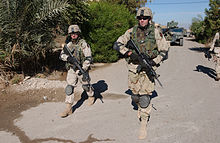
US infantry in Iraq

First lieutenant of the Bavarian Grenadier Guard Regiment 1814
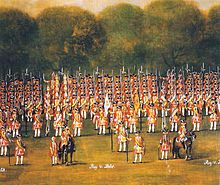
Electoral Hanoverian Infantry Regiment von Behr 1735 (1783: No. 7-A) at the review of Bemerode
Term origin
The term infantry originates from the Romance language area and possibly refers to the squire of a knight, who was called infante in Italian. This term in turn comes from the Latin infans "[small] child", composed of in- "not" and fari "to speak".
According to another explanation, the name infantry also goes back to the Infanta Isabella Clara Eugenia, daughter of King Philip II of Spain, at the beginning of the 17th century. The foot soldiers recruited at her command were armed in a new way, trained and called infanteria in honour of the Infanta.
In the German-speaking world, the term infantry first appeared in 1616 as a general term for foot troops. Until then, the terms "Fußvolk", "Kriegsvolk zu Fuß", "Fußknecht", "Haufen zu Fuß" and "Landsknecht" were commonly used.
Depending on their armament and mission, the infantry is divided into heavy infantry, today also mechanized, and light infantry, today usually also motorized with protected vehicles.
Gereon of Cologne and Saint Mauritius are considered in Christian popular belief to be the patron saints of infantry/soldiers.
History
Ancient
The forerunners of the infantry can be seen as the warriors and armies of prehistoric times, fighting individually at their own discretion, as we are told in traditions such as the Iliad, but also as the Europeans encountered them during the colonial period, especially in North America. A development to infantry can be read from the effort to decide a battle by a coordinated behaviour of many foot fighters more than by individual success. The emergence of standing armies and cavalry can also be counted among the preconditions for the development of the infantry. The emerging professionalization and fixed role assignment finally justify a delimiting designation.
The Phalanx
The term phalanx refers to a tactical formation of heavily armed and armoured infantry, as was common in ancient Greek culture in particular. The phalanx was formed by hoplites armed with a long lance and protected by armor and shield. The hoplites, who often numbered many thousands, formed the phalanx ten to twenty rows deep, close together with their lances stretched out in front (first rows) or on the shoulder of the man in front (rear rows).
The phalanx initiated the transition from single to formation fighting in ancient Greece. It was probably invented
by the Spartans in the 7th century BC.
For centuries, the phalanx was considered insurmountable for differently positioned foot troops, but it was not very mobile, unprotected from the rear and sides, and required great discipline on the part of the hoplites. At the Battle of Marathon, a Greek phalanx was victorious over far more numerous Persian troops who lacked the motivation and training to form such a highly ordered formation. The
tactical superiority of the phalanx ended with the introduction of the Leaning Order of Battle by the Theban general Epameinondas in the 4th century B.C. It was first used in 371 B.C. in the conflict between Sparta and Thebes at the Battle of Leuktra. In this, 10,000 Spartans are said to have been defeated by 7,000 Thebans.
See also: Hypaspistes
The Roman infantry
Similar to the Greeks, the Romans fought in the phalanx since about the 7th century BC. In the 4th century B.C., the rigid infantry formation was broken down into smaller closed units (maniple), which maneuvered according to the battle situation and were usually superior to Greek phalanx formations due to their mobility. In the attack, the Roman infantrymen first threw their javelins (pila) at a certain point of the phalanx and then charged into the gap thus created with drawn short sword (gladius).
The maniple were parts of large units - the legions. A legion was an independently operating military unit with a core of 4000 to 6000 men of heavy foot troops supported by mostly lightly armed auxiliary troops of about the same strength as well as cavalry. In today's terms it comes closest to the division. In the long history of the legion its strength, composition and equipment changed. The legion of the classical Roman imperial period was shaped by the army reform of Marius from 107 BC.
Both among the Greeks and at the time of the Roman Republic, the infantrymen as well as the horsemen bore the costs of their armament themselves. Conscription existed, and free citizens were assigned their function on the battlefield according to their economic capacity.
Medieval
→ Main article: Armament and equipment of medieval foot soldiers
With the end of the Western Roman Empire and the Migration Period, the cities largely fell into decay and with them the societies that had produced the infantry formations of antiquity. At the beginning of the 8th century, the stirrup also appeared in Europe and led to the emergence of heavy cavalry. By the end of the 10th century, knights had become the battle-deciding armament in Europe. Only the few cities maintained foot soldiers as the main armoury. For the "Fußvolk" throughout the Middle Ages one cannot speak of an infantry, because the armed servants, unlike an infantry, did not fight in tactical formation. They usually lacked drilled discipline. An exception was the Varangian Guard, the bodyguard of the Byzantine emperor, which initially consisted of Vikings.
Longbowmen
The English king Edward I first sought a greater role for foot soldiers in warfare again in the 13th century. He realized that hill tribes, such as in Wales, could not be defeated with short-serving squads of knights. He therefore introduced two important innovations which were to last for a long time: He raised an army of mercenaries serving the whole year and equipped it with the longbow, whose special advantages he had recognized. With a certain amount of practice, this weapon could be used to fire a well-aimed shot up to 90 feet, with an outermost range of about 140 yards. By a shower of arrows the enemy became alarmed at the beginning of a battle, and his piles lost their coherence. When attacking, the archers gave fire protection to their own troops.
In the Hundred Years' War, English archers equipped with the longbow on foot, interacting with dismounted knights and behind obstacles, again posed a threat to the mounted warriors of the Middle Ages for the first time.
See also: feudal system, Battle of Crécy, Battle of Azincourt
Landsknechte / Rice Runners
From 1386 (Battle of Sempach) onwards, the Swiss represented a true infantry for the first time since antiquity. Armed with spears and battle axes, tightly organized, trained and fighting in formation, they showed themselves superior to the knights. The infantry's form of organisation was called "Gewalthaufen". The effect of the force pile was based on the thrust of the mass moving forward in unison. The decision was sought in the attack. In 1485, the Spanish successfully led their infantry in this manner against the Moors. They became a model for other European armies.
Emperor Maximilian I and Georg von Frundsberg are considered the creators of the German infantry. They were the most important leaders and organizers of the Landsknechtheere. With them began the modern warfare. With the increasing re-emergence of a significant equestrian weapon and the introduction of firearms, the form of the Gevierthaufen as a defensive formation emerged among the foot troops. Arquebusiers and musketeers were the first firearm bearers of the infantry.
Firearms, which were now emerging, were at first understood as a coward's weapon and a threat to Christian morality and social order. But their effect was decisive, and that is why they were used. In his military science work Nef des Princes et des Batailles (1502), Robert de Balzac deals in depth with the use of firearms, the modern division of troops and the need to be ruthless in maintaining discipline and using scorched earth tactics.
See also: Hit Tactics, Rice Runner, Landsknecht
Janissaries
The Janissaries (singular of Janissary, Turkish Yeniçeri, "new troops") were the elite infantry troops in the Ottoman Empire. They also provided the bodyguard of the sultan and often reached the highest positions in the Ottoman polity. The troops originated in the 14th century and were disbanded in 1826.
See also: Ottoman Army
Scattered Lizards
Strelizen (Russian. Strelez "(bow)shooter", from Slav. Strela "beam, arrow") is the name given to the palace guard introduced by Tsar Ivan the Terrible around 1550, equipped with firearms and halberds (berdishi). They were known for their good training and loyalty to the tsar. The strelizi were soon expanded into a standing army of tens of thousands of men, making them the first regular professional army in Russia.
See also: History of Russia
early modern period
Swedish army reforms
Sweden's King Gustav II Adolf could not afford a mercenary army large enough to stand up to his enemies' armies, so he introduced conscription. He created the first popular army raised, paid, fed, and equipped by the state. Thus he recruited more than 40,000 Swedes who were "strong-minded and, as far as can be ascertained, brave - aged from 18 to 30 years." Members of professions vital to the war effort, such as munitions manufacturing and transportation, were exempted. The People's Army was not only better equipped economically and in terms of fighting morale than the armies of the enemy, which consisted mostly of mercenaries.
The composition and equipment of the Swedish army differed from those of other European armies, for they corresponded to the tactical ideas of the king, who attached the greatest importance to firepower and mobility. The most important weapon became the musket, and he increased the contingents of musketeers at the expense of pikemen. Like Moritz of Nassau, he divided his formations into smaller units and subunits. A company consisted of 72 musketeers and 54 pikemen.
Four companies formed a battalion, eight battalions a regiment, and two to four regiments a brigade. The musket became shorter and, as it had become lighter, could be brought to bear freehand. Loading was simplified, and the wheellock and paper cartridge became standard equipment. Also, the pike was now only about 3.5 meters long instead of 5 meters, and the armor had become lighter.
In such an army, which consisted of numerous smaller units, there were more officers than before, and a military hierarchy emerged. Furthermore, Gustav II Adolf did not let negligence pass and promoted his officers according to merit and performance. The responsibilities of the non-commissioned officers were extended. The introduction of uniforms and rank insignia contributed significantly to standardization and promoted fighting morale and esprit de corps. Henceforth the fighting power of the infantry depended on its firearms, the pike was also an assault weapon, but the main duty of the pikemen was to protect the musketeers during the lull in firing while charging, especially against the charge of cavalry.
See also: Thirty Years War
18th century: Linear Tactics
At the turn of the 18th century, due to technical developments, foot troops changed from heavy infantry, pikemen with protective equipment, to firearms carriers.
The infantry battalion was divided into four infantry companies, a small battalion staff and accompanying infantry guns. Each of the infantry companies was usually divided into four pelotons. Supply detachments and repair forces such as gunsmiths and cobblers were attached to the regiment.
The introduction of the bayonet in the second half of the 17th century brought a combination of the bare weapon with the rifle. In German-speaking countries, the line infantry was usually referred to as musketeers and as fusiliers. The change from matchlock rifles to flintlock rifles meant that the infantryman required less space on the battlefield. However, since the accuracy and range of the flintlock rifles was still low, it was important in battle to bring as many rifles as possible to bear at the same time. For this reason, the formerly more deeply structured formations of the infantry were replaced by flatter and broader battle formations, and linear tactics came into being. At the same time, the formation of the entire infantry in long, coherent lines served to prevent the desertion of soldiers pressed into service. This was also necessitated by the loading time for muskets. Muskets were not replaced by breech-loaders until about 150 years later, subsequently as repeating weapons.
Line tactics reached their peak during the Seven Years' War (1756-1763). Previously, with a rate of fire of one shot in three minutes, the cumbersome match rifle had been predominantly a defensive weapon. Now the musketeers' flint, combined with an improvement in the weapon's drill, made possible a cadence of five rounds in two minutes. The firing effect was still achieved by massing rather than by well-aimed single shots. Here, various forms of tuning - so-called fire drills - were possible. One can roughly distinguish between two different methods: In the former, a body of troops up to the strength of a battalion fired a volley - either all at once (rear limbs through the gaps of those in front) or staggered from front to rear (limb-by-limb firing). In the second type, either the half-companies (=pelotons) fired a rolling fire and, adapted to this rhythm, could also move forward peloton by peloton, or the troops fired - as in Austria, for example - a so-called running fire, which propagated from man to man. The effect of fire is disputed. With a range of the infantry rifle of 400 paces, a satisfactory firing effect was only given from about 300 paces (169 m).
The infantry in the second half of the 18th century, divided into half companies, fired according to a complicated system based on the even and odd numbers from the wings towards the center. The approach was never at a run, so as not to cause the troops to fall apart, but at a strong walk. Pace was 75 paces per minute according to the Prussian regulations of 1743. Fire was opened at a distance of about 300 paces, whereupon the pace was reduced to 40 to 45 paces with a simultaneous shortening of the stride. When the troops advancing against each other had come within 30 paces of each other, the rifle was felled with the bayonet fixed, i.e. advanced approximately horizontally. In Prussia, the rifle was no longer loaded, while the Austrians and Hanoverians used to fire from the hip once more.
See also: Muzzleloader, Line Tactics
Coalition Wars and the 19th Century
A change in the use of infantry occurred with the American War of Independence and the French Revolution. Whereas until then well-drilled soldiers often fought involuntarily in line tactics, these two armies were joined by volunteers who were, however, poorly trained. The recruits of the French People's Army were not at all capable of correct formation into lines and thus of using the previous tactics. The combination of fighting in dispersed order and in closed columns made up for the lack of training. Soon the advantages of the new battle tactics became apparent: while a line broken at one point had to admit defeat tactically, the firepower of infantry formed in several columns remained largely intact if individual columns became disordered. This system was perfected by Napoléon Bonaparte and adopted by all European armies from 1813 at the latest.
During the Thirty YearsWar, hunter battalions were already known since 1631. They were recruited from foresters and were established under the regency of Landgrave Wilhelm V of Hesse-Kassel as the oldest in the German-speaking area. These were tasked with engaging officers and gunners in particular in targeted fire. Hessian and other German contingents were then used in the American War of Independence in the late 18th century.
In North America, the boundaries between closed-order combat in accordance with the regulations and partisan fighting, also called "little war", became blurred: light infantry, inadequately drilled and poorly disciplined, achieved much acclaimed successes in dispersed action against the English. In Prussia, ten special riflemen were assigned to each infantry company in 1787. The riflemen, in a departure from the battle infantry, were not equipped with smooth-bore muskets, but with rifled rifles, which permitted well-aimed firing. In the attack, they were sent as swarms in front of the closely deployed units. In this way they forced a dispersal of the enemy's line infantry, which could no longer advance in a closed front. The closed units advanced echelon by echelon, the gaps between the units increased. The ability of the riflemen to fire well-aimed shots did not yet mean any appreciable increase in firepower. Their value lay mainly in disruption and concealment. When the distance to the enemy was reduced, the riflemen had to open fire independently, after which they were taken up by the advancing line. A decisive impetus to the further development of rifle tactics came from the French Revolution, in the wake of which the untrained masses could no longer be drilled with due thoroughness. The French formed themselves into lines, but sent dense swarms of riflemen in advance of them, who bore the real burden of the fight. This improvised procedure relied on enthusiasm rather than discipline and was accordingly inefficient. The French Revolutionary armies failed constantly until a new generation of officers had practiced the levée en masse.
Napoleon's reforms
From the very beginning of his career as a general, Napoleon's orders of battle were geared to the destruction of the enemy, the completion of which, however, was achieved through diplomatic-political conclusion. Napoleon's operations and battles were aimed at the decisive victory of annihilation, with highly efficient troops at his disposal in terms of spirit, means, structure and numbers. In doing so, Napoleon brought the three determining factors, the required "strategic trinity" of time, space, and force, into a harmony rare in the history of war. His directives for operations and battle were "free from all schematic dogmatism." The main thing was that the concentrically approaching large units arrived at the right place at the right time with superior strength to strike together. In this respect, Napoleon had to cope with a leadership problem that had existed since the traditional history of warfare and that could only be solved with the military use of telegraph, railways and an increasingly developed road network: the spatial and temporal coordination of the army units that Napoleon had mostly designed to bypass the enemy, but their consolidation in good time before the battle so that the necessary tactical dispositions could be made without friction. Since Napoleon, modern operations have been based on the principle that an offensive from two directions should not be conducted directly on the battlefield or the enemy from a prior concentration of all forces, but should develop from the depth of the operational area through the concentric deployment of separate army units.
- wearing down the opponent through concentric attacking actions and through elastic operation management
- Bringing about a defeat decisive for the campaign by encirclement with the aim of a military-political defeat
Attack Column
At the same time, another tactical innovation was adopted from revolutionary France, which further strengthened the tendency to concentrate the troops at greater depth: the attack column. To this the battalions were drawn up in four lines of three links each, about fifty rods wide. This form combined the advantages of the wide formation - the simultaneous use of as many rifles as possible - with the thrust of the deep formation. However, since the majority of the soldiers in the column did not come to fire, it was far inferior to the line in terms of firepower. All the more remarkable, therefore, is the weight which, in spite of this fact, was attached to the psychological element. Napoleon assembled large columns up to the infantry mass of a division and conquered Europe with this basic tactical form. For the artillery, the new tactics had drastic consequences: Their entanglement in the form of regimental pieces in the gaps between the formations ceased, their mobility was increased by making a part mounted. At the same time, the guns were divided into batteries and more and more were grouped between the columns to form alternating focal points. Thus the artillery deployment became an independent combat action, the deployed artillery mass a tactical unit. The cavalry retained its previous role during this period of upheaval. Mounted infantry were the dragoons, also called carabiniers in some armies, who used the horse only for locomotion and dismounted for combat. The mission and structure, however, was increasingly pushed into that of the cavalry, depending on the country.
See also: Coalition Wars
In the 19th century, various armies differentiated their infantry soldiers into roughly the following troop units:
- Prussia: musketeers, grenadiers, fusiliers of the line infantry, as well as hunters and riflemen of the light infantry.
- Austria: Line infantry as well as k.u.k. Feldjäger (with the Tyrolean Kaiserjäger and Windbüchsenjäger) and Grenzer (which were a mixture of line infantry and hunters).
- France: Line infantry with the Foreign Legion as well as Zuaven and Turku regiments as light infantry.
- Russia: Guard and line infantry and riflemen
- Italy: line infantry and grenadiers as well as bersaglieri (riflemen) and alpini (mountain hunters)
Breechloader
With the invention of the breechloader by Johann Dreyse in 1839, the rifle could be loaded from cover while lying down (which was contrary to the then still widespread attack doctrines from the Napoleonic era, shooting while lying down was considered dishonorable). Infantrymen who were still equipped with muzzleloaders had to load them standing up anyway. Another improvement, the cartridge magazine (Spencer-Carbine of the American northern states in 1864, was little noticed in Europe. However, as early as 1866, the Prussian army in the German War (also known as the German-Austrian War) was equipped with a breechloader as a Dreyse firing needle rifle, unlike the Austrians. In the further development of breechloaders in Europe, especially with the Gendarmerie rifle of the Viennese Fruhwirth 1872) and the sealing of the chamber (Chassepot rifle 1866), the shooting performance of a rifle was considerably increased. The Dreyse needle rifles could shoot effectively up to 300 paces (= 225 meters), the French Chassepot rifles up to 1600 meters.
See also: war of secession, snipers
Crimean War
The Crimean War was the first war in world history to be modern, especially in the technical sense. For the first time, infantry units were deployed on the British side that were continuously equipped with rifled guns (Enfield Rifled Musket in calibre .577 inch (14.65 mm), introduced in 1853, effective range approx. 800 metres). On the Russian side, on the other hand, smoothbore muskets were still used (effective range about 200 meters). The success of the British Enfield rifle led to Prussia equipping its entire infantry with rifled guns. The Crimean War was also historically the first trench and positional warfare. Furthermore, the Crimean War with the Battle of Balaklava challenged the use of the classic cavalry charge, as it was on the losing side against the modern, faster firing infantry weapons.
See also: trench warfare, positional warfare
Battle of Königgrätz
In the Battle of Königgrätz on 3 July 1866, Prussian troops met the Austrian army in the German War for supremacy in the German Confederation.
In terms of military history, the use of new weapon systems is noteworthy. The Prussians had the firing pin rifle, a modern rifle with cylinder breech (single-shot, no repeating rifle) and paper unit cartridge. Furthermore, the telegraph played a decisive role.
The significance of the Battle of Königgrätz should be seen both in the general political context and as a milestone in the development of military strategy in Europe. Königgrätz marked the beginning of the age of large-scale manoeuvres by massed armies that, in contrast to the Napoleonic era, fought pure firefights - the bayonet as a decisive weapon in battle, because it had to be used in the actual battle situation man against man, finally became historical through the rudimentary automation of small arms. At the same time, however, the tactic of order, the further development of the close ties of even middle-ranking troop officers to the strict operational guidelines of the army commanders, which originally resulted from linear tactics, and which can be traced back to both Frederick II and Napoleon, is applied on a large scale for the first time. Now, even company commanders - i.e. officers in the rank of captain or lieutenant - can make decisions at their own discretion in case of doubt without having to fear punishment by superior commands for disobedience.
Battle of Plevna
A significant change in the military thinking of the European powers was brought about by the Battle of Plewna in 1877, which is almost unknown in Germany today. Turkish defenders fought against attacking Russians. In the process, the Turkish soldiers had two rifles at once: a Peabody rifle in .45 caliber (single-shot) and a Winchester M 1866 underlever repeating rifle in .44 caliber. At distances of more than 200 meters, the Turks used the Peabody rifles, but if the Russians approached at less than 200 meters, the Turks put away the Peabody and took the Winchester rifle, with which they pelted the Russians with uninterrupted fire. The war was eventually lost for the Turks, but the Battle of Plewna had shown that firepower can decide a battle, as the Russians suffered losses of up to 60% in some cases. The German Reich did not get its first repeating rifle until 1886 with the M71/84, Switzerland had already preceded all European countries in this respect with the adoption of the Vetterligewehr in 1869.
Infantry Strength Comparison
Meyers Konversationslexikon (vol. 8, p. 944) brings the figures of European infantry strengths in 1888:
| Country | Infantry | light infantry |
| German Imperial Army | 165 infantry regiments with11 | 20 hunter battalions |
| Austria-Hungary | 102 infantry regiments | 1 Tyrolean Hunter Regiment, 32 Hunter Battalions |
| France | 144 infantry regiments | 30 hunter battalions |
| England | 112 infantry regiments with together | 1 rifle brigade with 4 battalions |
| Italy | 96 line infantry regiments | 12 bersaglieri regiments, 6 alpine regiments with 72 mountain companies |
| Russia | 192 infantry regiments, | 50 rifle battalions |
20th century
Even at the beginning of the 20th century, the infantry was the main weapon of battle. The regulations for the German infantry of 1906, which were still valid during the entire First World War, reflect the importance of this type of troop at that time: "The infantry is the main weapon. In conjunction with the artillery, it fights the enemy down with its fire. It alone breaks his last resistance. It bears the brunt of the battle and makes the greatest sacrifices. In return, it reaps the greatest glory."
The infantry in Germany was divided into musketeers and fusiliers of the line infantry regiments, hunters of the independent corps hunter battalions, and formerly in a broader sense also into dragoons, as the original mounted infantry, as well as the cavalry of the battalion-strong cavalry rifle regiments, which came into action dismounted during the First World War. Before 1900, the soldiers who were equipped with hand grenades as a means of combat in the grenadier companies were referred to as grenadiers. This means of combat was brought into use by all infantrymen during the war. The attack of the infantry is carried out until today in the Stoßtrupp, as already by the assault battalions in the First World War, which is characterized by covering fire as well as covered deployment with surprising break-in.
The main armament of the infantry from the end of the 19th century until the Second World War was repeating rifles, such as the Lee-Enfield in the British Army and the Mauser Model 98 in the German armies.
Until the beginning of the Second World War, all armies consisted mainly of infantry. However, their importance declined due to tanks and aircraft, because they could not keep up with the terrain gains of the tanks in the battle of movement.
In the German Wehrmacht, the troop type of panzer grenadiers was established to support the armored troops and for the combat of the combined forces. These were motorized or armored mechanized infantry with half-track vehicles, German Schützenpanzerwagen also SPW. Due to the equipment with armoured personnel carriers, infantry could fight even during an ongoing battle, mounted from the vehicle and from the movement. However, due to the lack of armor, only one of each armored division's armored infantry regiments, and often only one of the battalions, was equipped with half-track vehicles, while the others were equipped as motorized infantry with trucks, and had to dismount to fight. The Panzergrenadiers of the Panzergrenadier Divisions were motorized only.
The German infantry divisions with their three infantry regiments, which continued to make up the bulk of the Wehrmacht's army, were, in contrast, not motorized due to the lack of armor; artillery and hawsers were predominantly manned. Transport was by foot march or over long distances by rail.
Only very few divisions were therefore equipped for a war of movement as it was fought from 1939 onwards. While in offensive operations the infantry rushed after the mechanized troops, in retreating operations it could not follow them fast enough and was surrounded by enemy troops. The demise of the infantry during Operation Bagration 1944 was therefore inevitable.
The Jäger Division had only two Jäger regiments, and had only a reduced number of regiments and a smaller number of artillery divisions. These, in addition to the general combat mission of defending from and attacking field positions, mostly in open terrain, were capable of fighting in difficult conditions, especially wintry conditions, but were not capable of fighting in the mountains as the Gebirgsjäger were. The equipment corresponded to that of an infantry division of the Wehrmacht.
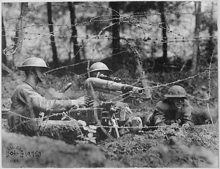
US infantry position, 1918
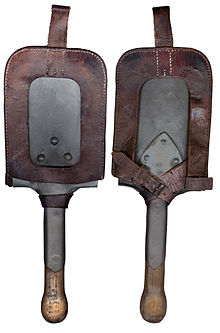
German field spade from the First World War; manufacturer: T.D.G., the handle was shortened after a breakage

Napoleon at the Battle of Jena, 1806
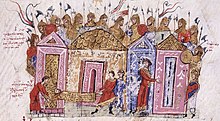
The Varangian Guard in the Chronicle of John Skylitz (12th century)
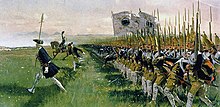
Attack of Prussian infantry in linear tactics - non-contemporary 19th century account by Carl Röchling

"The Five Landsknechte", iron etching by Daniel Hopfer from the early 16th century.

Phalanx maneuvering or forming
Search within the encyclopedia